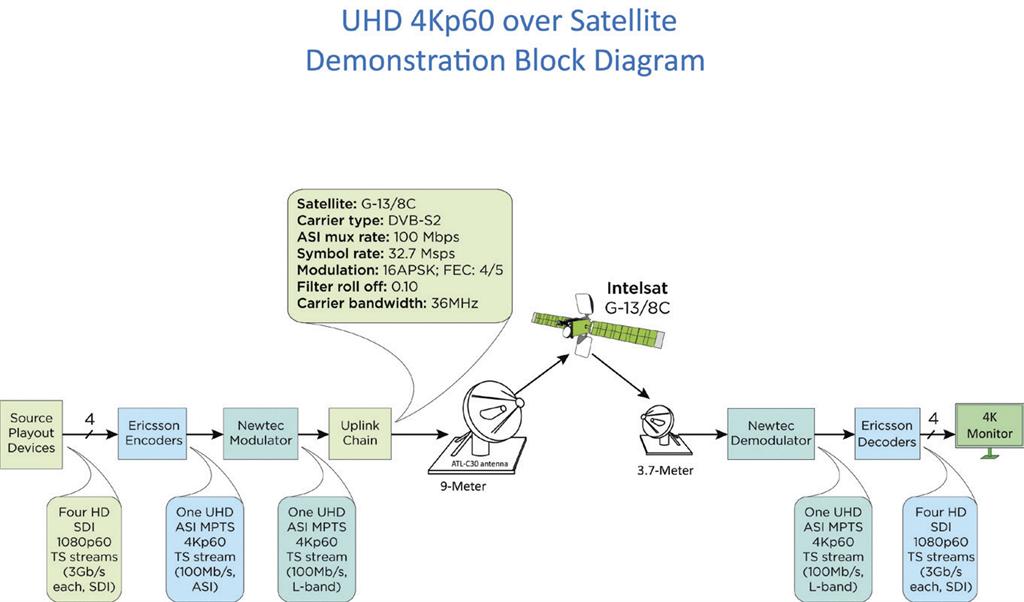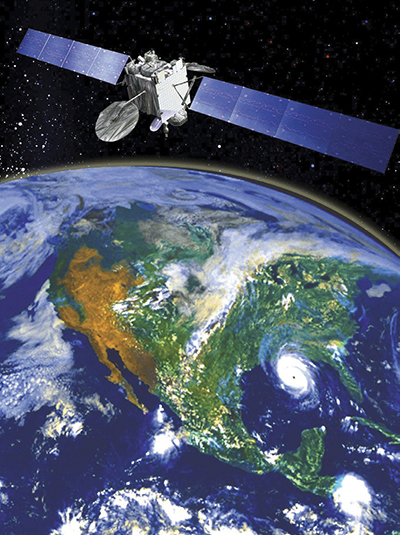Satellite Companies Prepare for Ultra HD
ALEXANDRIA, VA.—Satellite companies are getting ready for the coming age of Ultra HD: 3840×2160-pixel ultra-high definition TV, or more simply, 4K. They’ll be even more ready once everything else is in place—but no one is sure when that magic moment will occur.
Nor is anyone sure what the public acceptance will be of this technologically superior TV standard. The less-than-stellar success of 3D as TV’s “next great thing” has most observers hedging their bets on Ultra HD. How the public will view, and pay for, what is essentially an incremental upgrade from today’s HD is anyone’s guess.
NEW CODEC
As a result, according to interviews with satellite and infrastructure providers including Intelsat, Eutelsat, SES and Ericsson’s TV group, the satellite industry is making sure that their piece of the 4K transmission puzzle is ready for whatever their customers want them to do.

This diagram shows how Intelsat and Ericsson recently demonstrated an uncompressed 4:2:2 10-bit 4K UHD signal at 60 fps from Europe to TBS’s Atlanta facility over Intelsat Galaxy 13. Of primary importance to all players is a final version of a codec that will make possible the most efficient 4K transmission. The widely discussed High Efficiency Video Coding (HEVC) standard, which received initial approval by the International Telecommunications Union in January, is available in a first-stage approval version by the MPEG and the Video Encoding Experts Group (VCEG) study groups. Seen as the successor to today’s H.264/AVC HD standard, the new codec—also known as H.265—promises roughly a 50 percent reduction in data size. Once finalized, an array of newgeneration set-top boxes, 4K encoder/ decoders and other systems will move from what one observer called “a science project” to the marketplace.
Most observers also believe that 4K will not be a massive replacement for the still-developing rollout of HD technology. In all probability it will be first used by premium programming providers, and set-top boxes will need to be built that can handle multiple streaming formats.
This month’s IBC Show in Amsterdam will be the latest global showcase for the latest 4K infrastructure developments.
A Clearer Picture of 4K
The professional video industry's #1 source for news, trends and product and tech information. Sign up below.
Matthew Goldman The biggest issue confronting the rollout of 4K technology may well be misinformation, according to Matthew Goldman, Ericsson senior vice president, TV compression technology. While the company is working on infrastructure projects, Goldman believes that the satellite industry—and media—need to have a clearer understanding of the current stage of 4K development.

According to Goldman, true 4K is more than quadrupling pixels. It should include a 50-to-60 per second frame rate, and 10-bit data. Using that definition, many 4K demonstrations presented thus far have not been true “Ultra HD” showings. The HEVC standard, a key element of Ultra HD, is a work in progress; a final version is not scheduled to be released until next January (2014); transmission of live real-time Ultra HD broadcasts probably will not take place until 2015. He also believes that new consumer settop boxes will need to be developed to handle true live Ultra TV, and development of true HD decoder chips; and the settop boxes themselves will not available until approximately the end of 2014.
He also noted that Ericsson is the only vendor currently offering satellite service providers a complete solution for true live Ultra HD acquisition, exchange and distribution. In addition to last June’s demonstration with Intelsat, they are supporting Ultra HD trials by Measat using the Measat-3 satellite, and conducting Ultra HD/HEVC trials with Korea Telecom’s Skylife pay-TV service.
—Skip Ferderber
Among the year’s most significant 4K demonstrations thus far was held in June when Intelsat and Ericsson demonstrated an uncompressed 4:2:2 10-bit, 4K UHD signal at 60fps, delivering pictures from Europe to Turner Broadcasting’s Atlanta studios. Using Intelsat’s Galaxy13 satellite, the 100 Mbps video feed was encoded and decoded in real time using four Ericsson AVP 2000 contribution encoders and RX8200 receivers. Newtek provided modulation/ demodulation hardware.
According to Peter Ostapiuk, Intelsat vice president, media product management, the demonstration was unique, even though it required multiple HD-standard boxes to achieve the effect. Among other aspects, the test utilized 16 APSK modulation instead of DVB-S 8PSK modulation, generally used in today’s HD transmission, to increase the throughput to over 100 Mbps.
“Once you start using some of those more aggressive, higher modulation schemes,” he said, “signals are more susceptible to interference either in the same transponder, an adjacent transponder or an adjacent satellite. Satellite operators have to be very conscious in putting the 4K signal in a neighborhood that will keep them safe from interference.
Intelsat also plans to launch new high-performance satellites in 2015 and 2016 based on its Epic NG platform. The architecture contains “spotbeams” in the Ku and C bands that will enable improved 4K transmission; essentially better-focused footprints within a broader footprint. Ostapiuk noted this architecture is typically used today in Ka bands for consumer broadband operations.
DEMO CHANNEL
To assist the movement to a 4K future, Eutelsat launched a demonstration-only 4K service last January on its 10A satellite to help the TV industry collect real-world experience in producing and transmitting 4K content. Michel Chabol, Eutelsat director of digital cinema, 3D and Ultra HD, indicated that the satellite is operating in “Quad HD,” essentially four bundled HD streams transmitted with H.264/AVC at 40 Mbps. “We’re waiting for HEVC encoding,” he said, adding that the company is also awaiting a chipset that will enable the 50-60 fps frame rate necessary for 4K content viewing. He expects prototypes to be available early next year.
While changes will be required throughout the transmission chain, Chabrol does not believe that major structural changes will be needed to today’s satellite model, other than the introduction of HEVC and a successor to the DVB-S2 TV broadcast standard. He sees nothing to “radically change the principles of satellite broadcasting.”
Ultra TV will come about in two “flavors,” he added: today’s developing 4K standard, and at some future date, 8K, which will arrive “the day after tomorrow.”

Intelsat Galaxy 13 While both Intelsat and Eutelsat have demonstrated 4K using H.264, SES demonstrated the viability of H.265 as a transmission standard with the launch of a 4K satellite demonstration in April running the still-unfinalized HEVC standard. Thomas Wrede, vice president of reception systems at SES, noted that the demonstration is being seen in Europe via an ASTRA satellite at 19.2 degrees East. The HEVC standard features an up to 50 percent encoding efficiency improvement, compared to previous test broadcasts in MPEG-4 AVC.
CAUTION AHEAD
DirecTV and DISH, the two main consumer satellite services in the U.S., anticipate a 4K future but are hedging their bets on when it will happen.
“We are a natural fit and believe 4K will take off when reasonably priced 4K TV sets and more 4K content converge [are available],” DirecTV said in a statement.
Vivek Khemka, senior vice president of product development for DISH, indicated that a 4K service will require new chips and new compression but that the company will be ready for 4K when the demand is there. “[The transition] will be similar to the industry conversion from MPEG-2 to MPEG-4 and will take time to gain widespread adoption across pay-TV providers,” he said.
